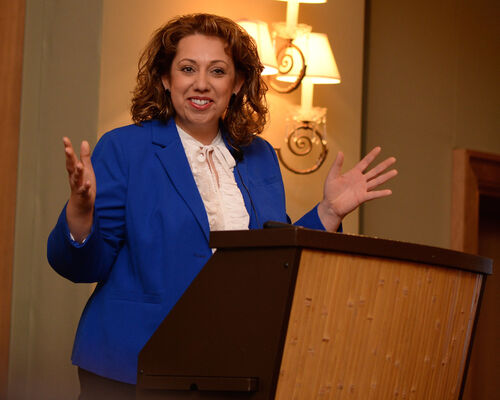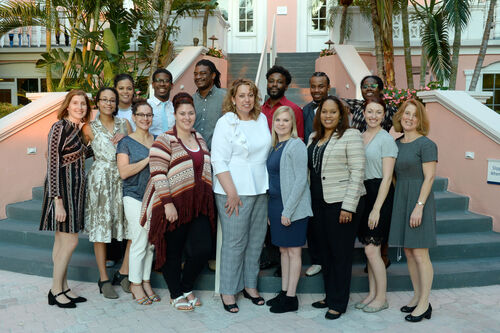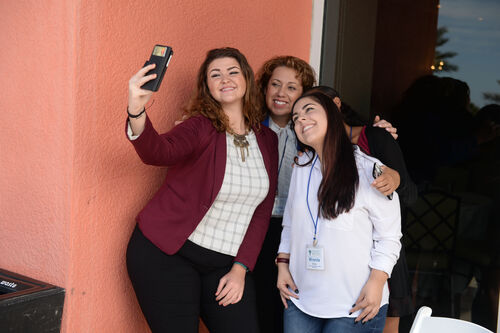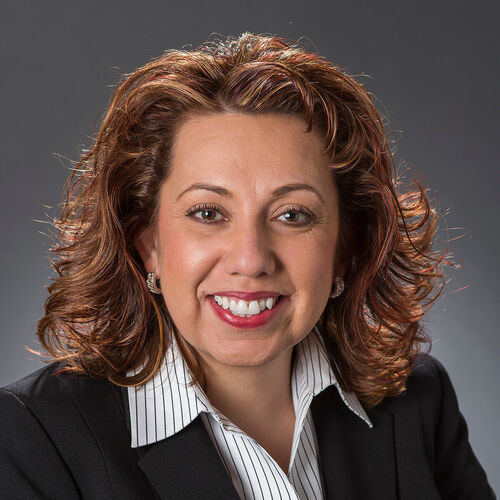Blog
Celebrating Women’s HERstory Month: Sandra Gasca-Gonzalez

As an agency founded and led by a Black woman, ASCI values the impactful contributions made by women of color who continue to lead with conviction and strength in order to best serve children and families. In honor of National Social Work Month and Women’s History Month, ASCI spoke with five influential female leaders in child welfare to highlight their powerful stories, impacts on children and families, and visions for the future.
Sandra Gasca-Gonzalez has devoted more than two decades to uplifting children, families and communities across the nation through empowerment and innovation. Her value for youth voices, family strengths and kinship care has enabled her to create meaningful programs to help youth and families drive their own process and strive for holistic well-being. In the future, Gasca-Gonzalez will continue working against family separation and finding new ways to support children, older youth and families on their own terms, while also encouraging and developing other leaders of color to take the helm when she’s ready to begin her next chapter in the child welfare space.
ASCI: How long have you worked in child welfare?
Sandra Gasca-Gonzalez: I have worked in child welfare for 24 years. I cannot believe it has been that long, and I was thinking about this the other day: I have worked in nine organizations. I have held 15 different positions in four states and the District of Columbia. The latest one is this role at the Annie E. Casey Foundation.
ASCI: And how long have you been with the Casey Foundation?
SGG: Six years.
ASCI: What made you choose to enter child welfare?
SGG: When I was 11 years old, I experienced the unexpected death of my father. That left my mom, brother and me what I perceived to be as alone. I believe people get into this work because of a personal purpose, and that was the case for me. My family was devoutly spiritual and believed in “praying the pain away.” Because of that, I spent many years suffering in silence without dealing with the core issues of the loss.
Being a Latina, in our culture it has not been a custom to be open about our feelings and struggles. I simply did not want other children to go through the pain of loss alone and in silence. We are not open in our community, although it has gotten better, but we need to encourage our people to get help when it’s needed. The Latino community tends to rely on informal family and supports, which I believe in, but I felt like there were times [when] I was really sad that I needed to see a professional to help me work through my grief.
That is why I decided I wanted to be an outpatient therapist to help children and families deal with trauma and loss. It really was at the age of 11 that I decided I was going to help people. I did not exactly know what that meant in my 11-year-old brain, but as I watched TV, I would see these therapists in these offices, so I thought, “That is what I am going to do.”
ASCI: What was the first position that you held? Is [therapy] what you started doing right out of school? How did your career develop into where it is now?
SGG: My first job was as an outpatient mental health therapist in rural Kansas, and after six months I changed my mind, because I did not like the harm that I saw systems doing to people. I was assigned the child welfare caseload as the new therapist in the office. That meant I would see the children who were separated from their parents, usually in the first 30 days, and I was tasked with giving a mental health diagnosis to children in foster care. This was challenging because the children were there due to no fault of their own, and they were scared, felt alone, and missed their parents. It did not seem fair to stigmatize them and pathologize families and their pain, sitting with the diagnostic manual and focusing on what was wrong with families instead of seeing them for their strength and their circumstance they were trying to overcome. Seeing the bar that was being raised for them is when I first realized how the system was structurally designed to set them up for failure.

That is when I decided to leave my job as a therapist and go to work inside the child welfare system to do everything possible so that children and families were not separated for long periods of time and that the system was disrupted from the harm it was creating.
ASCI: Those things you learned in that first job—what you did not want to do and then why you wanted to join the fight within child welfare—do you still find them relevant in your current work?
SGG: I continue to be reminded every day how hardworking people in the system are and even then, structural issues exist that separate families for issues of poverty and keep them separated for far too long. This is what I saw when I sat in that therapist office years ago. And the lessons I’ve learned on how to “disrupt” systems is really couched now in a way that makes sure families and young people who have experienced the system have a platform to voice their ideas and design system changes they want to see.
I have also learned the importance of supporting others who are beginning to develop their own leadership—especially women of color—so they can bring their authentic selves to the work, make bold change and rise above workplace barriers.
ASCI: You said you have been in the sector 24 years. In all that time, what have you found to be the most fulfilling work you have done?
SGG: Gosh, there is a lot that I think is fulfilling. Every seat that I am in, I consider it to be a seat of privilege, and I try to parlay the positional authority I might have to really create a platform for people who do not normally have a voice and for what is going on in the system to actually make the change. I use my formal authority to create space. What that actually looks like is, there are foster parents and kinship parents at the table deciding policies. There are young people who are being supported in designing solutions that affect their lives. And this is before it was popular like it is right now. This is back in the day when I would get so many side-eyes from my own staff and from my superiors, [before] they saw the outcome [and could say], “Wow, we actually were able to increase kinship care by 25% because we actually talked to kin families!” That seems normal now, but in 1999 and in 2003, that was not a very common thing to do.
“I use my formal authority to create space. What that actually looks like is, there are foster parents and kinship parents at the table deciding policies. There are young people who are being supported in designing solutions that affect their lives.”
Sandra Gasca-Gonzalez
I am very proud of just being willing to do those kinds of things when they were not popular and continuing to push things that are not popular but are necessary to [make] change.
One of the first things I do in any position I am in is ask the people who are working with me, who might report to me, what their aspirations are in terms of leadership, and then ask them what they need to build on so they can have my seat someday, so that they can be a leader and can someday take my chair. I am not one of those people who holds onto power. I want to share it and I want everybody to be a part of learning and building their own leadership capacity, especially for women of color who are often marginalized and often overlooked.
I can look back in my career in the different places I have been—and I am still in contact with many of them—and I see the great things [my former staff] are doing in their authentic selves, and I just love it.
ASCI: In addition to the changes you have been fighting for your whole career, what do you think are the biggest needs in the current child welfare system as far as reform? What do you think are the biggest changes that we really need to be chasing right now?
SGG: There is way too much expectation for the child protection agency to be the answer for families when the answer lies within families and their communities. For a long time, the child protection agency became the primary resource for serving [families], no matter how simple or complex the problem might be that a family is facing. I think we got way off track. Instead of separating children from families, the focus must be on strengthening families with the kinds of resources that will keep children safe at home and families stronger together. We must proactively support child and family well-being and prevent child maltreatment and unnecessary family separation.

Another area is making sure that young people do not age out of foster care. Addressing the potential for multiple generations of foster care alumni losing their children to the child welfare system has to stop, and it starts with making sure young people have the relationships, resources and opportunities to thrive as they go into adulthood. No child should leave the system without family.
ASCI: How is your current work making those changes possible?
SGG: Because we know that inequities exist for Black and Brown families in this country, we have targeted our approaches to the systems reform work by investing in strategies that support improving outcomes, especially for communities of color. These investments include embedding a race and ethnic equity and inclusion lens to the work. We have also built in the voices of young people and families that have experienced the system to drive practice and policy changes at the local, state and federal levels. We have a specific solution to permanency for older youth, which was youth-designed, that will be launching later in the year. It was 100% designed by young people who “aged out” of the system.
ASCI: Could you describe your top two accomplishments over the length of your career?
SGG: Good question. It’s hard to say. I think my colleague Gina has something in mind, because she keeps smiling at me. Maybe she can weigh in here
ASCI: Yes, Gina, definitely, if you want to chime in here.
Gina Davis (AECF Senior Communications Associate): There are two things that come to mind immediately. I have watched Sandra really lead with her values and lead with the values of the Casey Foundation. This has been really important as we consider the tendency toward reform fatigue, and it can be challenging to get people to buy in. But I’ve seen Sandra lead with such passion and energy, and at the same time fully appreciate that we have to work within processes and at the pace of other people. What I mean by that is, it takes a while for people to come along. Even if they believe you are on the right track, it can take a while for people to really buy into: “OK, this really is the right path.” I have just watched her strike this fascinating balance between patience and passion. She gets further in allowing people to come along at their own pace, but not slowing herself down. And I just think it is a fascinating strength of her leadership that she is able to balance that and get stuff done.
SGG: Thanks for that, Gina, and that gave me time to think a little bit, and it really does relate to the work that [ASCI] does. I remember being a young professional sitting with my values around my own personal family and what it took for me to be raised after my father passed away. It was my mom and all my aunts, my cousins, my uncles that rallied around me, so very early on in my career—again, when it was not popular and I do not even think we had the [Fostering Connections to Success and Increasing Adoptions Act] yet—I was always fighting against the mentality [that] “the apple does not fall far from the tree.”
“I feel like we need to look at children and families holistically, and we keep applying this lens of legal statuses. I know we are talking about child welfare, but there are so many young people in juvenile justice that should not be in detention, but could be with relatives.”
Sandra Gasca-Gonzalez
It is such a myth, so everywhere I worked, we pushed for kinship placements to be increased—not just increased but supported, financially and with an actual person helping support the family.
ASCI: That really is an accomplishment. So, how do you think kinship care has evolved over the stretch of your career, and where do you see it going? Do you see more state systems leaning into kinship care? Since you have been many different places and work nationally with a lot of different people, we are curious what that evolution looks like to you.
SGG: I think kinship care has evolved a lot in the last 24 years. I think laws have helped. I think funding has helped, but I do not think it has evolved enough. I think that some jurisdictions do kinship because it is a cost-saving measure. Some do it because it is family and it is the right thing to do. We need to look at children and families holistically, and we keep applying this lens of looking at them through legal statuses. I know we are talking about child welfare, but there are so many young people in juvenile justice that should not be in detention, but could be with relatives, and that is not a practice that is common.
I think that evolution needs to expand more holistically to address the needs of children and young people as opposed to focusing on a legal status determining whether you can live with relatives. Family is family and children need to be with family, and probably more controversial than anything is that I think we should not have excessive licensing standards for relatives in child welfare, nor should funding be contingent on licensing. We have made a lot of progress in the field, yet there is a whole lot more progress that still needs to be made, and it is places like [ASCI] that have actually really helped push this.
ASCI: There is always work left to do, but what specific benefits have you personally seen in your work with families and children? What tangible benefits do you see for families who are engaged in kinship care services?
SGG: The well-being of the children and the family overall is just stronger. I see kids doing better in school. They achieve the milestones they are supposed to achieve in education, compared to kids who are moving from foster home to foster home.
The normal things kids would do seem to be more grounded and rooted when kinship families are caring for their relatives and also getting the support to do that. Safety is super important and so is permanency, but well-being is actually all of that. If you are achieving optimal well-being, you are safe, you have a sense of belonging, and you get a sense of belonging by friends, activities, family, church, community, all of that. From my experience, children and young people that live with relatives are better equipped to handle their trauma, overcome their challenges, and thrive because they are in a familiar place.
ASCI: Do have suggestions for agencies like ours, or for traditional foster care agencies or even state systems that are really trying to incorporate kinship care more into their service delivery?
SGG: Lead with, “What will it take to keep these children with relatives or with family?,” rather than all the reasons why relatives can’t be the supports for a child and the family.
It’s important to show staff how to do “what it takes.” Show them what is possible and teach them what it will take to get to a different place. I think our policy implementation in general needs a lot more time and modeling for that to really change.
ASCI: Do you have any thoughts on the need for better oversight? Because, agencies may have county, state or federal policies in place, but what body is making sure we are adhering to them and that children and families are benefiting from them? Do you think child welfare agencies need such oversight?
SGG: Every agency should have a report card, just like kids have report cards. We have to be bold enough to do more of what’s working and courageous enough to stop efforts that not only aren’t working but in many cases are causing more harm to children and families. In 2018, we at Casey published Fostering Youth Transitions to start tracking how well systems across the country were doing at addressing the needs of older youth in foster care. We are working on the next iteration of that work and expect to publish it later this year.

I do not know if you have heard of our annual KIDS COUNT Data book. Fostering Youth Transitions is a bit of a supplement to that resource, with a focus on the child welfare system and older youth in foster care. It’s about accountability, and I think kinship and permanency are part of those indicators.
ASCI: Since we’ve been asking for your suggestions, we’re wondering: If a young woman of color came to you and expressed interest in entering the child welfare field, is ambitious and has a lot of inspiring ideas about how to make life better for children and families, what advice would you give her? What things would you want her to keep in mind as she just starts out?
SGG: Get a mentor and tell the mentor to help you stay authentic and true to your values, and make sure that you always treat others the way you would want your family to be treated. That is the North Star —how you would want your family to be treated.
ASCI: Yes, the golden rule for a reason, right?
SGG: That is right. There’s a saying out there about how life is an echo: what you send out – comes back, what you give – you get, radiate and give love – and love comes back to you.
ASCI: Looking ahead at what you want to accomplish from this point on, what are you most looking forward to as far as your career in child welfare and the work you want to do?
SGG: First of all, I never thought what I was going to be in a role like I am today. I thought I was going to be an outpatient therapist.
One thing I am really excited about is the Annie E. Casey Foundation’s partnership with Casey Family Programs, the Children’s Bureau and Prevent Child Abuse America in leading the Thriving Families, Safer Children effort. I am so excited about that. Thriving Families aims to demonstrate that it is possible to fundamentally rethink child welfare by creating the conditions for strong, thriving families where children are free from harm. Seeing children, young people and families truly supported and staying together is my immediate focus for the next five years.
I have learned that I tend to be more of a free spirit in where I feel moved and called to take action. Some people are surprised that I am working at a national foundation, because my career has always been working directly in systems and creating/leading change on the ground. The way I approach my career is that I work in places where I can have an impact, where I can lift the voices of those who do not have a voice and actually have an impact. Wherever I am, I know that I am supposed to learn, grow and support systems and communities working together to have transformative change that supports families to thrive.
